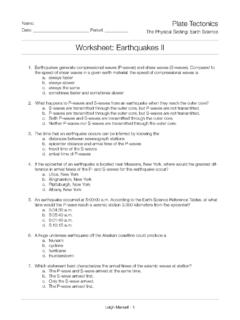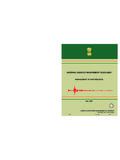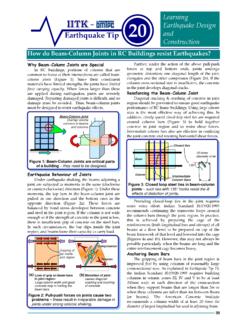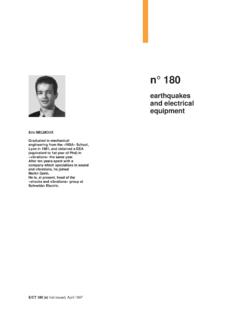Transcription of SEMI-EMPIRICAL PROCEDURES FOR EVALUATING …
1 SEMI-EMPIRICAL PROCEDURES FOR EVALUATING LIQUEFACTION POTENTIAL DURING EARTHQUAKES by I. M. Idriss and R. W. BoulangerDepartment of Civil & Environmental Engineering University of California, Davis, CA 95616-5924 e-mail: & Invited Paper Presented at The Joint 11th International Conference on Soil Dynamics & earthquake Engineering (ICSDEE) and The 3rd International Conference on earthquake Geotechnical Engineering(ICEGE) January 7 9, 2004 Berkeley, California, USA Proceedings of the 11th ICSDEE & 3rd ICEGE pp 32 56 Abstract SEMI-EMPIRICAL PROCEDURES for EVALUATING the liquefaction potential of saturated cohesionless soils during earthquakes are re-examined and revised relations for use in practice are recommended.
2 The stress reduction factor dr, earthquake magnitude scaling factor for cyclic stress ratios (MSF), overburden correction factor for cyclic stress ratios (KV), and the overburden normalization factor for penetration resistances (NC) are discussed and recently modified relations are presented. These modified relations are used in re-evaluations of the SPT and CPT case history databases. Based on these re-evaluations, revised SPT- and CPT-based liquefaction correlations are recommended for use in practice. In addition, shear wave velocity based PROCEDURES and the approaches used to evaluate the cyclic loading behavior of plastic fine-grained soils are discussed.
3 Keywords Liquefaction, SPT, CPT, earthquakes. INTRODUCTION SEMI-EMPIRICAL field-based PROCEDURES for EVALUATING liquefaction potential during earthquakes have two essential components: (1) the development of an analytical framework to organize past case history experiences, and (2) the development of a suitable in-situ index to represent soil liquefaction characteristics. The original simplified procedure (Seed and Idriss 1971) for estimating earthquake -induced cyclic shear stresses continues to be an essential component of the analysis framework, although there have been a number of refinements to the various components of this framework.
4 Other major developments in the past thirty years have included improvements in the in-situ index tests ( , SPT, CPT, BPT, shear wave velocity), and the continued collection of liquefaction/no-liquefaction case histories. The strength of the SEMI-EMPIRICAL approach is the use of theoretical considerations and experimental findings to establish the framework of the analysis procedure and its components. Sound theory provides the ability to make sense out of the field observations, tying them together, and thereby having more confidence in the validity of the approach as it is used to interpolate or extrapolate to areas with insufficient field data to constrain a purely empirical solution.
5 Purely empirical interpretations of the field case histories, without any physics-based framework, would leave unclear the conditions for which the empirical relations truly are applicable. For example, the purely empirical derivations of individual factors of the analysis method ( , an MSF, dr, or KV relation) are complicated by their dependence on other components of the analysis method, and thus a purely empirical derivation is often not well constrained by the available case history data. This paper provides an update on the SEMI-EMPIRICAL field-based PROCEDURES for EVALUATING liquefaction potential of cohesionless soils during earthquakes.
6 This update includes recommended relations for each part of the analytical framework, including the: x stress reduction coefficient dr, x magnitude scaling factor MSF, x overburden correction factor KV for cyclic stress ratios, and x overburden correction factor NC for penetration resistances. For each of these parameters, the emphasis has been on developing relations that capture the essential physics while being as simplified as possible. These updated relations were then used in re-evaluations of the field case histories to derive revised deterministic SPT-based and CPT-based liquefaction correlations.
7 Lastly, shear wave velocity SV based liquefaction correlations and the PROCEDURES for EVALUATING the cyclic loading behavior of plastic fine-grained soils are discussed briefly. OVERVIEW OF THE FRAMEWORK USED FOR SEMI-EMPIRICAL LIQUEFACTION PROCEDURES A brief overview is provided for the framework that is used as the basis for most SEMI-EMPIRICAL PROCEDURES for EVALUATING liquefaction potential of cohesionless soils during earthquakes. This overview provides the context in which the dr, MSF, KV, and NC relations are derived and used. Each of these factors is then revisited in subsequent sections.
8 The Simplified Procedure for Estimating Cyclic Shear Stress Ratios Induced by earthquake Ground Motions The Seed-Idriss (1971) simplified procedure is used to estimate the cyclic shear stress ratios (CSR) induced by earthquake ground motions, at a depth z below the ground surface, using the following expression: SEMI-EMPIRICAL PROCEDURES for EVALUATING Liquefaction Potential During Earthquakes I. M. Idriss1, R. W. Boulanger1 1 Department of Civil & Environmental Engineering, University of California, Davis, CA 32 Plenary Sessions 33 vo 'VV (1) in which maxa is the maximum horizontal acceleration at the ground surface in g's, voV is the total vertical stress and vo'V is the effective vertical stress at depth z.
9 The parameter dr is a stress reduction coefficient that accounts for the flexibility of the soil column ( , dr = 1 corresponds to rigid body behavior) as illustrated in Figure 1. The factor of is used to convert the peak cyclic shear stress ratio to a cyclic stress ratio that is representative of the most significant cycles over the full duration of loading. Adjustment for the Equivalent Number of Stress Cycles in Different Magnitude Earthquakes The values of CSR calculated using equation (1) pertain to the equivalent uniform shear stress induced by the earthquake ground motions generated by an earthquake having a moment magnitude M.
10 It has been customary to adjust the values of CSR calculated by equation (1) so that the adjusted values of CSR would pertain to the equivalent uniform shear stress induced by the earthquake ground motions generated by an earthquake having a moment magnitude M = 7 , , . Accordingly, the values of are given by: vo 'MSFVV (2) Use of the SPT Blow Count and CPT Tip Resistance as Indices for Soil Liquefaction Characteristics The effective use of SPT blow count and CPT tip resistance as indices for soil liquefaction characteristics require that the effects of soil density and effective confining stress on penetration resistance be separated.






